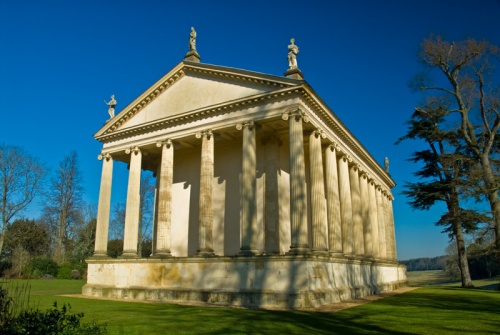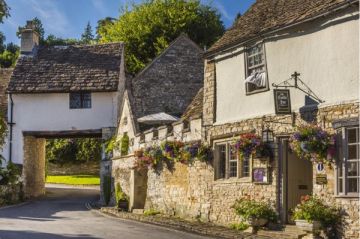
Stowe has a place in gardening history. It was one of the first, and certainly the most influential, of what came to be called 'landscape gardens'. For more on the development of landscape gardening see our article here.
The gardens evolved from an earlier formal Baroque garden laid out around Stowe House, home of the Temple-Grenville family. In about 1718 Richard Temple, Baron (later Viscount) Cobham decided to replace that formal garden with one that was more in keeping with his own sense of what a garden ought to be.
To help him realize his vision, which was fueled as much by political fervour as artistic sensibility, Cobham called in Sir John Vanbrugh, the architect of Blenheim Palace, and Charles Bridgman.
Working with their patron, Vanbrugh and Bridgeman began the alteration of the earlier gardens at Stowe into a classical landscape of temples and grottos, walks and vistas. William Kent and James Gibbs were brought in to work with Bridgman, who died in 1738. He was succeeded by perhaps the most famous and successful landscape garden designer of all time in the person of Lancelot 'Capability' Brown.

Stowe evolved continuously until Brown left to pursue his own very successful career in 1751. Over the following centuries, the landscape softened as the trees planted by Brown grew, but at the same time, the classical temples felt the passage of the years.
More to the point, the Temple-Grenville family felt the passage of their fortune, aided by the spendthrift 2nd Duke of Buckingham. In the early 20th century the house was sold and went through several hands until it became a private school. The garden was eventually taken over by the National Trust, and now over 40 monuments have been restored and preserved for us to enjoy.
Stowe is not a dramatic garden; it is not intended as such. Instead, it is a garden to amble through. There are winding paths and hidden terraces, sheltered groves and sudden, unexpected vistas that cry out to be admired. There are more classical temples than I could describe in this article, so I'll settle for special mention of a few.

Palladian Bridge
The Palladian Bridge seems to be a magnet for visitors. The bridge crosses the tapering south-west corner of the Octagon Lake. The term 'Palladian' refers to Andrea Palladio, a 16th-century Italian architect who popularized a style of architecture reminiscent of ancient Rome and Greece. The Palladian Bridge follows that classical outline. It originally stood much higher out of the water than it appears today, but the lake level has risen considerably over the years.
Temple of British Worthies
This crescent-shaped temple stands beside the River Styx in the Elysian Fields. It is composed of one long arcade, into which are set niches, each bearing the bust of a British notable.
The 'worthies' are divided equally between people of action and those of intellect, so here we find such diverse worthies as William Shakespeare and Edward, the Black Prince, Queen Elizabeth I and philosopher John Locke. What is so intriguing about this temple is not the architecture, which is lovely, but rather, who was deemed worthy of inclusion or exclusion.
The Temple of Ancient Virtues
Clearly, Lord Cobham harked back to an earlier time, when the heroes of the ancient world lived in a [highly idealized] world of knowledge and civic virtue. The statement would have been even more obvious if the counterpart to the Temple of Ancient Virtues, the Temple of Modern Virtues, had survived. Sadly it did not, but perhaps you can guess at Cobham's intent when you know that the Temple of Modern Virtue was designed as a ruin. Hmmm ...
Visiting Stowe
There is a lot to see at Stowe. The gardens are immensely popular, so on sunny weekends it can be crowded. However, the area of the gardens is huge, so it never feels like you are overwhelmed with other visitors. The paths are generally very good, but there are some steep sections and some areas that could be slippery when wet.
See if you can time a trip to one of the open days for Stowe House, which offers a wonderful glimpse into the background and lives of the family that created these marvellous gardens that we can still enjoy. To get a better sense of what Stowe Landscape Gardens has to offer, click on the link below to visit our Photo Gallery, which offers a bit of a virtual tour around much of the gardens.
Related:
Landscape Gardens
About Stowe Landscape Garden
Address: Buckingham,
Buckinghamshire,
England, MK18 5EQ
Attraction Type: Garden
Location: 3 m NW Buckingham, off A422
Website: Stowe Landscape Garden
Email: stowe@nationaltrust.org.uk
National Trust - see also:
National Trust memberships (official website link)
Location
map
OS: SP665 366
Photo Credit: David Ross and Britain Express
HERITAGE
 We've 'tagged' this attraction information to help you find related historic attractions and learn more about major time periods mentioned.
We've 'tagged' this attraction information to help you find related historic attractions and learn more about major time periods mentioned.
Historic Time Periods:
Find other attractions tagged with:
Capability Brown (Person) - Georgian (Time Period) - Restoration (Historical Reference) -
NEARBY HISTORIC ATTRACTIONS
Heritage Rated from 1- 5 (low to exceptional) on historic interest
Stowe House - 0 miles (Historic House) ![]()
Water Stratford, St Giles Church - 1.5 miles (Historic Church) ![]()
Buckingham Chantry Chapel - 2.4 miles (Historic Church) ![]()
Old Gaol Museum - 2.5 miles (Museum) ![]()
Chetwode, St Mary & St Nicholas - 3.8 miles (Historic Church) ![]()
Hillesden, All Saints - 5.1 miles (Historic Church) ![]()
Thornton, St Michael's Church - 5.3 miles (Historic Church) ![]()
Furtho, St Bartholomew's Church - 7.8 miles (Historic Church) ![]()
Nearest Holiday Cottages to Stowe Landscape Garden:
Syresham, Northamptonshire
Sleeps: 4
Stay from: £395.00 - 2678.00
Middleton Stoney, Oxfordshire
Sleeps: 8
Stay from: £1066.00 - 5673.00
Ludgershall, Buckinghamshire
Sleeps: 2
Stay from: £350.00 - 781.00
More self catering near Stowe Landscape Garden














